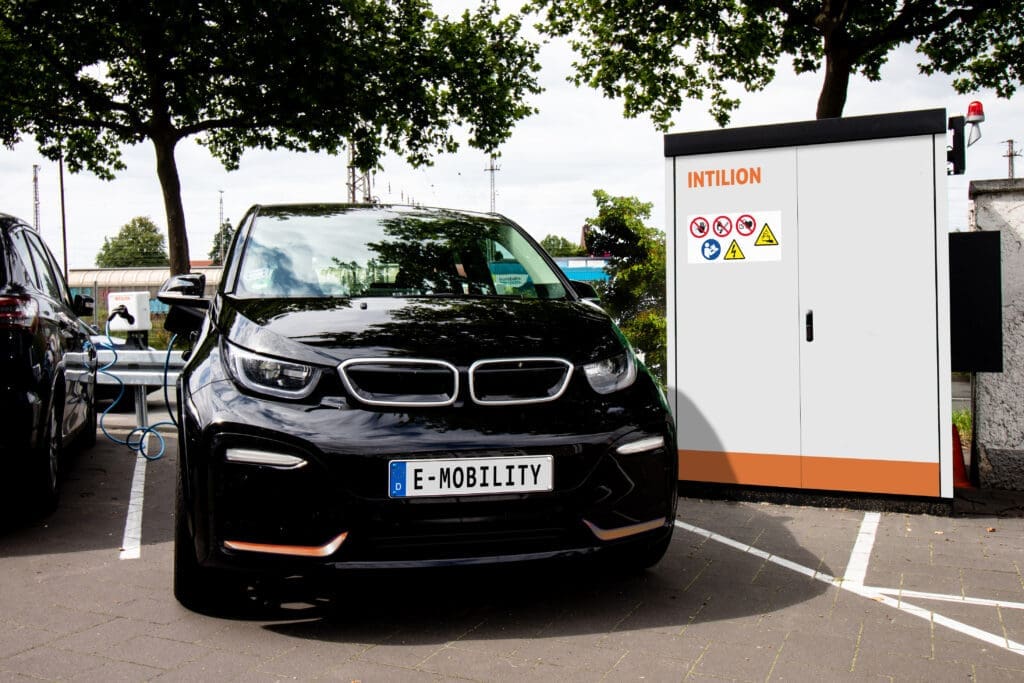Energy storage: the key technology for the future energy transition
Germany’s energy transition is making impressive strides, but alongside the major solar and wind projects, a quiet revolution is unfolding: the integration of energy storage systems. This key technology is crucial for balancing the fluctuations of renewable energy sources and ensuring a stable power supply. Energy storage systems are thus not merely an addition, but the backbone of a future-proof energy infrastructure.
- 8 Min.
The energy transition is in full swing and Germany is reaching impressive milestones in the use of renewable energies. With a 56 % share of public electricity generation last year and solar energy expansion targets exceeded, the path to a sustainable energy system appears to be paved. Yet, beyond the media spotlight, a silent revolution is taking place that is just as crucial as the expansion of wind and solar energy: the integration of energy storage systems into the energy infrastructure.
Why are energy storage systems important?
While headlines are often dominated by large solar parks and wind farms, energy storage systems play a crucial behind-the-scenes role in the energy transition. These silent helpers are essential for balancing the fluctuations of renewable energy sources and ensuring a stable electricity supply. Whether as home storage units, in large-scale projects, or as part of the growing electric vehicle fleet, energy storage systems offer versatile applications and are becoming the backbone of a future-proof energy supply.
The role of energy storage systems in decentralised energy supply
Energy storage systems play a significant role in decentralised energy supply. They enable households and companies to become more independent from the public electricity grid by generating and storing their own power. This enhances the resilience of the energy system and allows for a flexible and sustainable energy supply.
In decentralised energy systems, energy storage systems can store excess energy generated by photovoltaic or wind power installations. This stored energy can then be used when generation is low or demand is high. This ensures continuous supply and better integration of renewable energies.
Moreover, energy storage systems can help improve grid stability in decentralised networks. They can balance fluctuations in electricity supply and contribute to reducing peak loads. This leads to a more stable and reliable power supply in decentralised energy systems.
Decentralised energy supply with energy storage systems also offers benefits for consumers. It enables greater independence from energy suppliers and better control over energy consumption. Additionally, consumers can benefit from financial incentives such as feed-in tariffs for self-generated electricity.
Overall, energy storage systems play a crucial role in decentralised energy supply and contribute to implementing a sustainable and resilient energy system.
If you are planning your energy storage project, please contact us.
The development of energy storage
Over the past decade, the energy storage market has rapidly developed. Batteries with a total capacity of 8.1 gigawatts and 12.5 gigawatt-hours are already integrated into the German power grid. Despite these impressive figures, the market still holds significant untapped potential. Driven by technological advancements and falling prices, the expansion of storage solutions is set to continue in the coming years. Particularly, stationary large-scale storage systems are becoming increasingly attractive and offer diverse applications—from grid services to the integration of renewable energies and participation in electricity trading.
This development is not only a technical challenge but also opens up new economic perspectives. Investors, project developers, and energy suppliers see energy storage as a promising opportunity to benefit from the energy market’s transformation. Innovative marketing strategies and optimised models for utilising storage capacities can yield attractive returns, contributing to the financing of further projects.
But it’s not only stationary storage that is in focus. The growing fleet of electric vehicles in Germany also holds enormous potential. With an estimated storage capacity of 105 gigawatt-hours, these “rolling” batteries could play a significant role in future grid stability. Through bidirectional charging, electric vehicles could not only absorb energy but also feed it back into the grid, contributing to the flexibility and resilience of the energy system.

Where is the journey going?
In the coming years, it will become clear how well we can fully exploit the potential of energy storage and integrate it more deeply into the energy landscape. One thing is certain: energy storage systems are far more than just an additional technology—they are the unsung heroes of the energy transition.
What do the experts say?
In a contribution by Tobias Kurth, Energy Market Expert at Montel, Dr. Alex Schmitt, Battery Specialist at Montel, and Sebastian Ligewie, Analyst at Montel, you will find valuable insights into energy storage systems and their significance for the energy transition, as well as information on integration and marketing of energy storage solutions.
Silent revolution: how battery storage is driving the energy transition
Last year, the share of renewables in public electricity generation was celebrated in the public spotlight: it reached a record figure of 56%, exceeding the expansion targets for solar energy. This sends a clear signal that Germany is on the right path towards transforming its energy system.
There is no doubt that this is good news. However, the expansion of wind and solar energy is only one component in establishing a resilient and self-sufficient energy system. In comparative silence, politicians and the public are discussing an equally important building block: energy storage systems.
Battery storage systems play a key role, particularly for short-term storage, and are an indispensable element of the energy transition. This has long been recognised by experts and decision-makers in energy companies. Hardly any other market has undergone such rapid change as the market for battery storage systems. Over the last ten years, batteries with a total storage capacity of 8.1 gigawatts and a capacity of 12.5 gigawatt hours have been installed in the German electricity market. Even if these figures are impressive, the potential is far from exhausted.
But how are battery storage systems integrated into the energy systems? “Battery storage systems are real all-rounders,” says Tobias Kurth, energy market expert from the Berlin-based analysis company Montel. “Their potential applications are diverse and now go far beyond use as home storage systems. Lithium-ion batteries in particular have already proven what they are worth in applications such as system services or peak shaving, as they can provide power efficiently and quickly,” explains Tobias Kurth.
Home storage systems form an excellent team along with solar energy systems and, therefore, enjoyed enormous popularity in the past. Until now, it has mainly been smaller lithium-ion storage systems with capacities of 5 to 10 kilowatt hours that have been installed. The entire sector currently comprises a battery capacity of 10.5 gigawatt hours with an output of 6.5 gigawatts.
However, home storage systems are by no means the only dynamic area of the battery market. Driven by technological progress, batteries are becoming increasingly cost-effective. As prices fall, there is also a clear trend towards ever larger storage systems.
In particular, large-scale stationary storage systems were able to benefit from this and have become increasingly attractive for the market. Large-scale storage systems, usually defined as storage systems with a capacity of at least 1 megawatt hour, currently account for 1.5 gigawatt hours on the German battery market. Their potential uses range from system services and the integration of renewable energies to arbitrage trading on the spot market.
However, the market believes that the growth potential in this segment is far from exhausted. Further large-scale storage projects with a total capacity of 2.2 gigawatt hours are planned by 2027, which will double the installed capacity in this area within a few years.
But how lucrative can battery storage systems be marketed? Montel uses a multi-market optimisation model to assess the revenue potential of battery storage systems on the market, thereby evaluating the potential of the spot and balancing energy markets in an iterative process. This provides investors, project developers and banks with a solid basis for the monetary evaluation of storage projects.
As a concrete example, the marketing of a 1-megawatt/1-megawatt-hour storage system was simulated for various years. Optimised bidding on the short-term markets enabled the storage system to generate around €75,000 in the pre-crisis year 2021. If the primary balancing energy markets were also taken into account, this figure would double to nearly €136,000. Many operators took advantage of this opportunity, meaning that the pre-qualified capacity of battery storage systems for the provision of primary balancing power rose sharply within just a few years.
Over 750 megawatts of capacity have now been prequalified in this market. Battery storage systems are the only growing technology segment on the primary balancing energy market. This trend has not been without consequences: prices have fallen due to growing competition and the comparatively low supply costs of battery storage systems. The marketing simulation for 2022 and for Q1 to Q3 2023 showed less significant differences between spot and balancing energy marketing.

Dr Alex Schmitt, battery expert at Montel, comments: “Until now, the primary balancing energy markets have offered an attractive marketing opportunity. However, we are now seeing that these markets are already saturated and the additional revenue for battery storage has cooled off somewhat.”
“In the future,” he continues, “secondary balancing energy markets could also be considered as another form of marketing. Marketing is much more complex here due to the asymmetry of the products and the price mechanisms, but batteries can offer power in both directions at the same time thanks to their technical properties. This makes this market extremely attractive for battery storage systems.”
However, in addition to large-scale stationary storage systems, a completely different market segment is increasingly becoming the focus of attention: the “rolling” storage systems of electric cars. Over 1 million electric vehicles and almost 900,000 plug-in hybrids are already on Germany’s roads, offering an enormous storage capacity of 105 gigawatt hours.
According to the German government’s plans, the number of vehicles is set to rise to 15 million by 2030. In order to be able to integrate these rolling storage units into the energy system, they would have to be equipped with bidirectional charging technology. “Integrating the e-car fleet as a short-term storage element is not only extremely interesting for the economy as a whole, as synergies are tapped here and sector coupling is taken to a new level, but also for individual vehicle owners, who can tap into new business models,” says Dr Alex Schmitt. “For example, it is conceivable that e-car owners could release their vehicles for bundled marketing to provide system services during downtimes. This could also open up additional sources of income that could give electric mobility a further advantage.”
In conclusion, it can be said that battery storage systems are already far more than just a complementary technology in the energy landscape. Even if the potential here is far from exhausted, and we only seem to be at the beginning of the battery ramp-up, they are already the flexible backbone of the energy system. They enable us to better supply industry and households with cost-effective electricity from renewable sources.
Do you have further questions?
Then book a free online consultation with one of our experts for your energy storage system.




